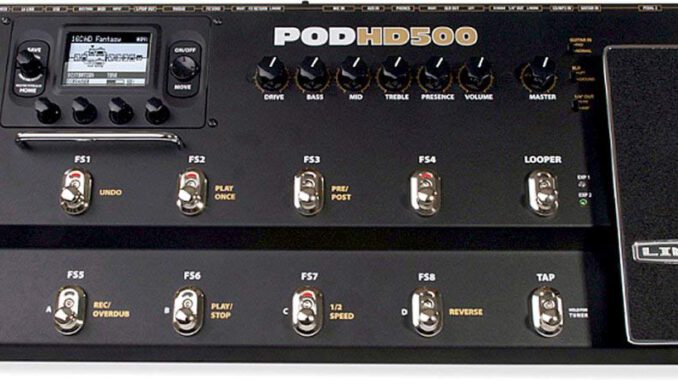
Over the past decade, I have always used some variation of POD for recording. It is by far, the easiest and fastest method of recording guitars. But when I’ve tried taking those sounds to the stage, they have sometimes fallen a bit short.
So when I was approached for my take on the new POD HD500, and I was told that “all-new” Line 6 HD modeling technology “represents a giant leap forward for amp modeling” and delivers “previously unachievable realism,” I plugged in with some skepticism.
Gimme The Cake
Do the models actually sound and feel like the real amps? Do they behave as uniquely as the classics they aspire to be? When I back off my guitar volume, will the amp model clean up and maintain the similar tonal characteristics of the original tube amp? The answer is a very emphatic, yes.
Each and every last one of the 16 HD amp models created with this new generation of modeling technology sounds and feels like the real deal to me. There is a very authentic, overall tube warmth that has been oh-so-close but not quite there in earlier generations. The HD amp models responded as I expected to the varying dynamics of my playing. Subtle differences in pick angle and force were plainly evident. Switching from pick to fingers, even using the most overdriven, maxed-out high gain tones, elicited the tactile reaction I hoped for.
Most remarkable to me was the natural from-end compression and power amp “sag” that happens when you crank a tube amp and dig in with your playing. This very real feel and response was also found when I began to add overdrive and distortion effects to the front end of the signal chain. Every amp’s front-end will react differently to the same pedal, and the new Line 6 HD models responded like they should.
Thick Layers of Luscious Icing
Ever the skeptic, I thought perhaps with all the focus placed on building the new modeling technology, and selecting, restoring and modeling a new collection of vintage amplifiers. Line 6 may have been forced to skimp on the effects. Nope.
POD HD500 contains a full compliment: over 100 pro-grade effects found in their acclaimed M-Series pedals. 30+ distortions, EQs and compressors; 35+ analog and digital delays, echoes, wahs, and reverbs (from surfy springs, to studio plates, to cutting-edge digital rooms); 45+ swirly phasers, filters and other mods including opto and bias modulating tremolos, choruses, and rotary speakers. And if that’s not enough, there’s a 48-second looper and pitch/intelligent harmonizer effects on board as well.
Easy to Digest
In what I believe to be the true test of a company’s ability to think like a guitar player and design a unit that performs well during a heat-of-the-moment, middle-of-a-song tweak, I refused to look at the POD HD500 manual. (Not only am I not going to take the manual to the gig, but I’m not going to spend hours burning the midnight oil studying it like a law student preparing for the bar.)
The new interface Line 6 developed for the POD HD500 is a guitar player’s dream come true. The display shows a series of easily recognizable icons laid out in a signal path just like a real-world amp and effects rig. Spin a knob and select an amp model, which loads with the appropriate speakers and cab. Don’t like them? Spin the knob and audition them all until you find the one you like. Add your effects anywhere in the signal path—before or after. Don’t like it there? Hit the “Move” button and place it somewhere else, just like you would in the real world.
Literally, within minutes, I had created and saved half dozen tones using unique amp models and effects rigs that truly sounded as distinctive as their real world counterparts, without looking at the manual.
Going Back for More
From the first not I played through the new POD HD500, I knew something was different about it. And not just in the quality of the tone but in the feel, which, at the end of the day, makes all the difference in the world.
Source: Musician’s Friend
– Jack Sonni
….
If my memory serves me well, Line 6 was the first company to actually advertise the actual name of the amps they modeled. They even took it a step farther claiming to not model based on schematics or theoretical, but discussing and describing specific amps to which they painstakingly compared in order to ensure ultimate authenticity, an absolutely brilliant marketing move painting the illusion of owning a room full of expensive vintage amps at a very affordable price. As such Line 6 has long been a leader in the world of modeling, but to a great degree the tones generated have been a bit polarizing with some championing the accuracy of their modeling while others claiming their digital algorithms can never compete with the real thing.
Even among those who embrace digital modeling, there has been a lot of criticism of fizz in the high gain models and an overall lack of feel. Line 6 looked to address these criticisms with the release of their new HD series which feature all new “high definition” modeling algorithms rebuilt from the ground up. The initial hype has a great many toting the Line 6 party line, but are these new floorboards really all that? Let’s dissect their current flag ship model, the POD HD500, and find out…
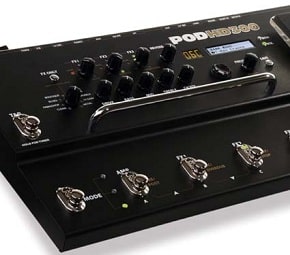
First off, this is an very feature ridden processor rivaled only in complexity, assign-ability, and internal routing by Boss’ GT-10, a unit often criticized for it’s complexity. Line 6 has opted for an architecture based around the unit’s DSP (digital signal processing) limit rather than locking the user into a set order or number of effects. This feature is unique to the 500 in the HD line and offers the user a virtual signal chain which can be split in to dual signal paths and any effect (up to 8) can be placed in any order on the main or within either of the split chains. You want five tubscreamers and three delays? You got it. Want to run dual parallel pitch shifters? You got it! How about dual amps? You got it…almost. This is where you start to run into the DSP limit. The unit can handle any two amps fine but try to add much more than a dirtbox and reverb and you’re out of luck.
While the ability to run dual amps in parallel will be a feature I imagine studio cats and home recording enthusiasts will dig, the live usage of this feature is a little limited unless you’re more bread and butter when it comes to effects. Virtually any parameter can be assigned to the on board dual expression pedal (a toe switch toggle between expression one/two), optional external second expression pedal, or toggled on./off by eight of the ten footswitches (looper, tap, bank up/down are reserved).
The switches can even be assigned to toggle multiple effects. And patch changing is super fast, fast enough that I you could easily call it instant. Very nice! The POD HD 500 includes numerous ins/outs including dual XLR/1/4” outs, headphone output, a main and aux input, XLR mic input, MIDI, SPDIF, USB, Variax (for use with Line 6 Variax guitars), and Line 6 Link (for coupling to the new DT line of amps).
Programming the unit is actually pretty intuitive. All the amp controls (and the master volume) have dedicated knobs across the face of the unit allowing quick and painless adjustment. Everything else is controlled by a bank of four rotary encoders which offer an intuitive matrix style control.
The first dial selects the category of effect, second the specific effect, third the effect parameters, and forth the parameter’s value. A four way button control, four flush mounted buttons and a dual knob/button are provided for some of the deeper functionality and system settings of the unit. But all this talk about features and programming is nonsense if the unit doesn’t sound good, so let’s get to it.
…the Park 75 and Marshall JTM-45 MkII models are perhaps the most authentic…However, my favorite amp model may be the Divided by 13 model whose dual interactive gain controls allow a wide range of gain options covering almost any style…
Line 6 has pared down it’s gargantuan list of amps modeled in its previous generation of products down to 16. That’s right, only 16! While this seems rather slim compared to the competition, they’ve carefully selected a nice collection of timeless classics and modern boutique amps which run the tonal gamut. The list consists of the Bogner Uberschall, Divided by 13 JRT 9/15, Dr. Z Route 66, ENGL Fireball 100, Fender Bassman, Fender Blackface Deluxe Reverb, Fender Twin Reverb, Gibson EH-185, Hiwatt Custom 100 (DR103), Marshall JCM-800 (2204), Marshall JTM-45 MkII, Mesa/Boogie Dual Rectifier, Park 75, Supro S6616, Vox AC-15, and Vox AC-30 (Top Boost). Before speaking on how things sound, a brief note on Line 6’s modeling approach. Line 6 doesn’t take the approach of trying to model an idealized version of an amp, but strive for ultimate realism including the warts and all. If the modeled amp exhibits ghost notes when playing in certain registers, so does the model. Even the AC hum is modeled. One the one hand, I must applaud their dedication and they get an A for effort. But all the same, I wish Line 6 had allowed more control over these tonal idiosyncrasies allowing them to be dialed down or turned completely off.
Now to the tones. In this reviewer’s opinion, the Park 75 and Marshall JTM-45 MkII models are perhaps the most authentic. Vintage Marshall tones have been a strength of Line 6 products since I can remember. The low end delicately teetering between big/warm and tight, the complex mid-range, the krang, it’s all there and it sounds damn good. If your tonal Nirvana lies between Angus and Eddie, I think you’ll be more than satisfied here. A big surprise was the Gibson EH-185 which I keep finding myself coming back to. I’d never even heard of this amp prior to giving the HD500 a spin, but its certainly an amp I’d love to check out in person. The AC-30 is among the better I’ve heard nailing the Vox chime and shimmer and though I’ve never played a Dr Z, I’m certainly digging Line 6’s interpretation of it balancing bite with a nice slightly saggy attack. However, my favorite amp model may be the Divided by 13 model whose dual interactive gain controls allow a wide range of gain options covering almost any style, at lower gain settings it has a sweet high end clarity and rich mid range crunch which blues and country players are really going to dig but upping the gain gets you firmly into roots rock and even 70’s era hard rock. I could easily do a whole gig with just some minor variations on this model. Very nice!
I didn’t have quite the same enthusiasm for the completely pristine side of things. Now I’m being a bit picky and holding Line 6 to a high standard based on the marketing of this new line, but the response when trying to dial things in absolutely clean without a hint of breakup isn’t quite there. Things just feels a bit stiff for lack of a better word, particularly with the Fender models. In fact, I did not find the overall dynamic response/feel to be significantly better than the competition nor close to dynamic as several analog dirt boxes I have, and I’m talking affordable options not high dollar boutique stuff. I should add that this appears to be a minority opinion based on the general consensus on several forums, as such your mileage may vary. Even with that criticism, I must state that every model is more than usable…a situation which is rather uncommon with modeling devices which typically include a plethora of choice with only a few models which are actually usable. I’ve run the unit in every possible scenario I could, into a pair of M-Audio monitors, using a few different types of headphones, into the front of a VHT Special 6, and into the returns as well as using the 4 cable method with both a Tech 21 Trademark 60 and ZT Club. While the unit performed admirably in all the scenario’s, things sounded most convincing using the return of the Tech 21 TM60 with the POD’s cabinet emulation disengaged. I should note that the response of the return of the TM60 is far from flat and full range, so take that for what its worth.
Line 6 has included a bunch of extremely inspiring synth-like filter and ambient pad styled effects…Fans of artists like Radiohead, Muse, and the Edge will have a blast dialing in everything from resonating howls to cosmic chirps.
Another big selling point of the HD line is the incorporation of Line 6’s hugely popular ‘M’ series of effects. First off, the looping on the HD 500 is implemented better than any of the competition by a long shot. It is always available by clicking the dedicated looper footswitch and once engaged, seven of the eight middle footswitches are dedicated to triggering looping and playback (including ½ speed and reverse). You can even toggle into and out of looping mode with the loop still playing and switch patches. Unlike some of the competition which treats looping as sort of an after thought, Line 6 has really given looping its due respect. Kudos! Also very well implemented is delay of which multiple flavors are included to meet the appetite of almost anyone from dirty and dingy to pristine and everything inbetween. I wasn’t as inspired by the dirt boxes, of which the selection are overly focused on fuzz pedals. While Line 6 did a very good job with the Tubedrive and Screamer models (the Chandler Tube Driver and Ibanez Tube screamer, respectively), a couple others come off a touch brash. Even more discouraging were the Univibe and Rotary effects which sound like some kind of modulated tremolo instead of the swirling ramp of the real deal. Another slight disappointment was the lack of control provided in the compressors. Granted, they’ve included controls of the modeled originals but the majority offer only two parameters; a real handicap for those who like precise control over their compression ratio, attack, and sustain. One more little bother is that modulation effect speeds are denoted in hertz. While this is technically accurate, I’m a musician and think in beats per minute (BPM) not cycles per second. Thankfully, Line 6 also included the option of musical division of beats easily synced to the tap tempo switch.
Back on the plus side of things, Line 6 has included a bunch of extremely inspiring synth-like filter and ambient pad styled effects for the more experimental player. In fact, the analog sounding girth and growl on tap are among the best I’ve experienced without requiring dedicated hardware and/or a hexaphonic pickup. Fans of artists like Radiohead, Muse, and the Edge will have a blast dialing in everything from resonating howls to cosmic chirps. You can even get pretty close to the synth lead tones of Metheny and Holdsworth. Honestly, I’ve not played another modeling device with the breadth and quality of avant garde effects allowing the transformation of your guitar into more or less a synthesizer. The vast majority of these effects are intended for monophonic usage, which feels a touch limiting at first. However, the unexpected glitchy-in-a-cool-way results of playing two or more notes on a couple settings was simply mind blowing. I realize these effects won’t be appreciated by many, but the fact that Line 6 choose to include them anyway is a huge plus in my book. Two thumbs way up!
Finally, the pitch effects are well delivered. Tracking was spot on even during fast runs and the tone of the synthetic harmonized notes is very organic and glitch free. I didn’t particularly care for how the smart harmony effect was programmed using a relative key identifier for mode. Being a player who thinks in chord/mode combinations rather than relative major key, it would be far more intuitive to select “A Dorian” rather than “G Major” when choosing a preferred harmonization for a Amin7 chord.
The POD HD 500 certainly offers a lot to love. The $499 price tag is quite a bargain considering the flexibility of programming/virtual routing and the quantity/quality of effects. While the modeling is generally good to great, things still have a touch of Line 6’s sonic fingerprint. And in my opinion, the claims of a vastly improved feel are just a touch oversold. If you’ve never been a fan of the sound of Line 6 gear, amp model-wise this unit might be a bit of a hard sell. But the POD has oh so much more to offer than just amp modeling. Anyone considering an all in one floor processor would be doing themselves a disservice by not checking out the POD HD 500.
POD HD300 – $459.99 MSRP
POD HD400 – $559.99 MSRP
POD HD500 – $699.99 MSRP
Pros: Good to great amp modeling/effects, flexible routing/programming architecture
Cons: Poor rotary/univibe emulation, difficult to dial in pristine clean tones which retain an organic feel.
….
My Line 6 POD HD500 High Gain Patch
I’ve been using my Line 6 POD HD500 in live situations for about two years now. I go direct into the mixer with no guitar amp whatsoever. My stage volume is handled by a QSC powered PA speaker. Initially I had trouble dialing in a high gain patch that worked, but over time I’ve learned some of the secrets of getting a good high gain sound out of the POD HD500. Most sound guys roll their eyes at me before the show when I tell them before a show that I go direct, and then routinely tell me after the show that I’ve got the best direct sound they’ve ever heard. I’d like to share some of my secrets for dialing in a good high gain sound with you here today, as well as putting my high gain patch up for free download.
Amp Model
The best amp model for high gain is the Treadplate (and its matching cabinet). It’s important to understand that when it comes to modeling, you’re never going to achieve exactly the same sound that you would hear out of a real world signal chain. So forget about dialing in the Marshall JCM800 with the Tube Screamer in front of it, because that combination (to my ear, anyway) doesn’t sound all that great with the POD.
Microphone Model
This is going to sound weird, but skip over the SM57 models and go all the way to the bottom of the list of mics. Pick the 87 Condenser (a model of the Neumann U87). The 87 Condenser is the only mic that gets rid of the “ice pick in the ear” high gain digital sound that is so often associated with modelers without lopping off so much top end that you can’t add it back with your treble and presence knobs.
Cabinet Settings
If you haven’t updated the firmware on your POD, make sure you’ve got the latest version. Line 6 added some cabinet tweaking options that are critical to beefing up your tone and making sure that it doesn’t disappear in a live mix. Once your POD is on the latest firmware, go into the cab parameters and increase the thump setting. The default is 50/100. I increased mine to 70/100. This fills in the “punch in the chest” feel that you can get from a real amp but that so many modelers can’t deliver. The thump setting controls the frequency range that makes palm mutes nice and punchy. Without it you’ll be forced to use gobs of gain to get punchy palm mutes… way more than necessary. With it you’ll be able to dial in a sound that won’t feed back at you like a wounded animal every time you stop playing.
Lead Boost
I stole this idea from the Line 6 forum, but it’s great so I’ll mention it here. Get yourself a short patch cable and connect FX SEND on the back of your POD to the L/MONO effects return. This will allow you to enable the FX Loop effect in your patch and dial in a clean solo boost for whatever dB level you want. I’ve got mine set to 5 dB. Then you can map that effect to one of you foot switches so you can enable and disable your lead boost on the fly during shows.
Effects
I’ve got a noise gate active at all times, but with decay set at 0% and the threshold at only 15%. This stops any buzz that I might pick up from the lights at some of the venues, but doesn’t interfere at all with sustain.
Aside from that, your effects are up to you. The core of your sound will already be in place. I like a bit of reverb and not much else.
Live Setup
As I mentioned earlier, I use a QSC powered PA speaker instead of a guitar amp. This allows the POD HD500 to simulate everything: amp, mic, effects and cab. It’s important to remember that if you want to dial in a great sounding patch for going direct, you have to have a direct setup at home so you know what your settings will sound like when you get to the venue. If you dial in your sound through an amp and then try to go direct once you get to the show, you’re screwed.
Odds and Ends
I’ve got high output passive pickups on my guitar, so you might have to adjust the gain setting a bit to tailor the patch to your guitar. Also, I like mid-heavy, 80’s sounding high gain. If you want a more scooped sound, you’ll need to adjust your EQ settings accordingly.


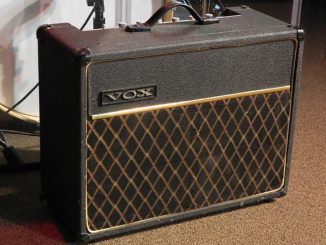
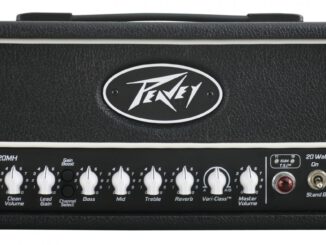
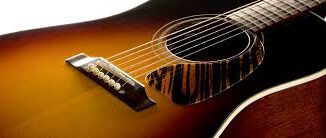
The author of this article said he “put up” his live patch somewhere, but I was unable to find where he put it, nor did the article have his full name associated with it. If it’s on the Line 6 Customtone site, I haven’t been able to search for it successfully. I’d like to try that patch with my old HD500 thru my PA if someone could tell me where it was. This question comes to you in 2023, and I know it’s an old article, but I’d appreciate it if anyone could direct me to the patch. Thanks!
I believe the patches were on YouTube back in the mid-2000s and have since been removed.